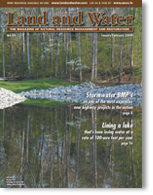Features Available Online
Determining What’s Wrong With Your Stream
Collaboration on the Little Scioto River Leads to an on-line tool for conducting casual analyses of biological impairmentsby Susan Cormier and Aaron Ferster
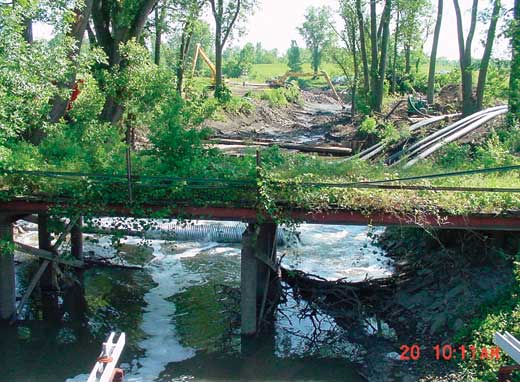
Dewatering stream. In background is the sheet metal retaining structure, a backhoe in dewatered area and return floor in foreground.
Sediment in the Little Scioto River in north-central Ohio was so contaminated in the late 1990s that gas-filled creosote bubbles regularly broke the water surface, spreading iridescent rainbows on the slow-moving water. There was trouble below the surface, too. The fish and aquatic invertebrates showed clear signs of biological impairment: low species diversity, fewer fish, and fish in poor condition. These same conditions also existed in North Rockswale Ditch, a nearby tributary flowing directly into Little Scioto.
Officials from the Ohio Environmental Protection Agency were the first to document the severity of the problem. A state-wide biological monitoring program by the Agency ranked the biological impairments in the Little Scioto among the worst in the state.
The Little Scioto and North Rockswale Ditch are downslope from the site of the former Baker Wood Creosote Facility located just outside downtown Marion, Ohio. Environmental officials believe waste from the facility, where creosote and other chemicals were used to make pressure-treated wood, was dumped directly into sewers that drain into North Rockswale Ditch.
The Ohio EPA was joined by a team of researchers from the U.S. EPA who were looking to collect contaminated fish in an effort to develop new methods for measuring pollution exposure in wildlife. They were particularly interested in polycyclic aromatic hydrocarbons (PAH), carcinogenic chemicals found in petroleum and petroleum byproducts, such as creosote. The two agencies joined forces to focus on the Little Scioto River.
The teamwork has paid off. Not only did the collaboration yield new ways to characterize PAH exposure, but the team returned to the site a few years later to help develop a comprehensive, web-based tool for watershed coordinators, aquatic biologists, TMDL coordinators, and others to use for determining the causes of biological impairments in their local waterways. That tool, the Causal Analysis/Diagnosis Decision Information System, or “CADDIS,” is now available through the U.S. EPA’s Web site.
Fish Studies
The team’s first explorations of the Little Scioto were aimed at developing methods for measuring PAH exposure in fish. The challenge was that PAHs, unlike other contaminants such as heavy metals and the pesticide DDT, don’t accumulate in animal tissue. That leaves no evidence to look for in the fish’s fat and other tissue, so the environmental scientists set out to develop new methods to detect exposure.
The team found what they were looking for in bile. In fish, PAHs are chemically modified (metabolized) into a water soluble form that is excreted in bile. To look for clues for creosote contamination, the researchers collected bile stored in the gall bladders of fish, then used it to develop a new method for measuring PAH metabolites.
The new method uses a standard spectrofluorometer to measure the wavelength of light emitted from samples of fish bile diluted with water. It is fast, accurate, and easy to use. This new analysis procedure does not require the time consuming clean-up procedures typical with chemical analyses of soils and biological tissues.
Using the new method, the team set out to conduct an assessment of the Little Scioto. Not surprisingly, they found that extremely high levels of PAH metabolites in the bile of fish taken from the river below the confluence of North Rockswale Ditch.
Soon after the new PAH measurement methods proved effective in field tests on the Little Scioto, collaborations among Ohio EPA and the U.S. EPA (primarily through its Regional Environmental Monitoring and Assessment Program) expanded the geographic scope of the initial project, spreading out to characterize background levels of exposure to fish in select streams throughout Ohio and the mid-Atlantic Highlands.
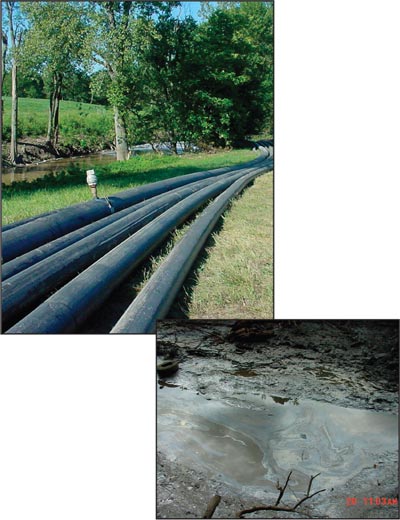
Top: Moving a river of water. Inset: Oil residue seeping out after dewatering stream.
Returning to the Scene
The simple method that helped characterize PAH exposures in the Little Scioto has since been used to assess biological conditions in other rivers, as well as for a marine system in Scandinavia. And the experiences and methods gained while studying the Little Scioto have gone beyond developing this important test.
When the U.S. EPA’s Office of Water asked for participants to help provide guidance for developing scientifically-sound methods for determining the causes of biological impairment in aquatic systems throughout the country, the collaborators from the Little Scioto PAH study were there to help. They offered to develop approaches for determining causes of biological impairment (causal analysis), while simultaneously building a case study focused on their previous study of the Little Scioto.
The team found that the Little Scioto River could be divided into three general geographical segments—upper, middle, and lower—based on the biological conditions they observed.
- Upper
Biologically unimpaired, the upper regions of the river had a diverse community of fish and invertebrates. - Middle
The middle segment exhibited less biological diversity, with a fish community dominated by the presence of large carp. The probable cause for that impairment was attributed to channelization and deepening of the stream, as well as alterations of stream habitat and water quality. - Lower
The lower reaches of the Little Scioto were the most impaired. The fish community had decreased diversity and fewer fish. In addition, individual fish were smaller, and showed an increased incidence of external anomalies and lesions. The biological impairments observed here were consistent with toxicological effects associated with exposure to PAH, metals, and ammonia. (Heavy creosote contamination began approximately 270 meters upstream from the confluence of North Rockswale Ditch.) Although the chemical contamination was sufficient to cause the biological impairments, the contaminated portions of the Little Scioto was also affected by the same channelization problems as the middle segment of the river.
Cleaning Up
Findings from the case study clarified remediation options and likely environmental outcomes. However, the results of the causal analysis were unknown to the U.S. EPA and Ohio EPA resource managers negotiating the remediation of the Little Scioto. A decision was made to focus remediation on removal of the contaminated sediments.
Managing expectations of recovery potential is critical for evaluating remediation success. For the lower segment of the Little Scioto, removing sediment alone, through dredging could reduce exposure to chemical contamination; however, the biological condition would be expected to improve to levels similar to those in the middle segment of the river. Achieving conditions of the most upstream segment of the river would also require extensive, habitat restoration efforts.
| The first step was to build treatment cells in the river using sheet piling. Water was pumped around the cells to maintain normal flow. Once water was removed from treatment cells, the underlying sediments were mixed with cement kiln dust, and removed and loaded into trucks. |
Due to the severity of the biological impairment and the shear volume of contaminants in the sediment, the Ohio EPA requested assistance from the U.S. EPA’s Region 5 Removal Branch. After conducting a remediation assessment of the river in May, 2000, U.S. EPA determined that approximately 4 miles of the Little Scioto constituted an “Emergency” situation and secured $6,000,000 through the Oil Pollution Act.
The first phase of the sediment removal project occurred from June through November, 2002. The first step was to build treatment cells in the river using sheet piling. Water was pumped around the cells to maintain normal flow. Once water was removed from treatment cells, the underlying sediments were mixed with cement kiln dust, and removed and loaded into trucks.
To isolate any remaining contaminants from the water column, all excavated areas of the ditch and river bed were backfilled and recompacted with a least two feet of clay soil material. Several areas of hydrologically porous sand/gravel soils were excavated and backfilled with alternating layers of recompacted clay and bentonite.
During the first phase, approximately 1/2 mile of North Rockswale Ditch and 1/2 mile of the Little Scioto were cleaned, generating a total of 42,000 tons of creosote-contaminated sediment.
To commence with the next phase of the project, Ohio EPA obligated $1 million to be used for additional cleanup at the Little Sciota River site. In addition, the Agency requested federal assistance, yielding an additional $2.5 million from the U.S. EPA Superfund removal program.
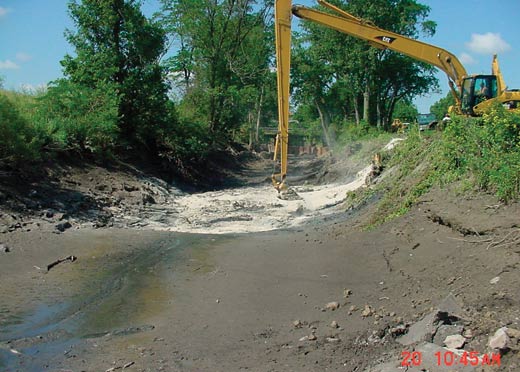
Kiln material added prior to removal of contaiminated sediment.
On May 22, 2006, the U.S. EPA mobilized their contractors to the site to begin Phase 2 of removal activities. That phase was completed on September 28, 2006. Approximately 3/4 mile of river was cleaned and 31,000 tons of contaminated sediment were removed and disposed of at a landfill. Treatment cells and bypass pumping of river water were again used to enable access to safely remove contaminated sediments during this phase of the project.
Total cost to date of the multi-year river cleanup effort is $9.5 million. At least 2.2 miles of the Little Scioto are yet to be cleaned, and the cost of tackling this section is projected to cost at least $20 million. Ohio EPA is currently evaluating potential funding opportunities, and plans to collaborate further with U.S. EPA to evaluate the performance of the previous efforts to reduce contaminants, as well as the effectiveness of the remediation to reduce PAH exposure to fish. With the more active communication between the several groups, some habitat restoration may also be considered in further phases of remediation.
CADDIS
Experiences, innovative exposure assessment techniques, and case studies generated from scientific efforts to analyze and subsequently restore Little Scioto River and North Rockswale Ditch helped usher in a new generation of ways to assess causes of biological impairment in aquatic systems.
The method for determining the probable cause for biological impairments became U.S. EPA guidance in 2000 and was updated recently and published on-line at www.epa.gov/CADDIS.
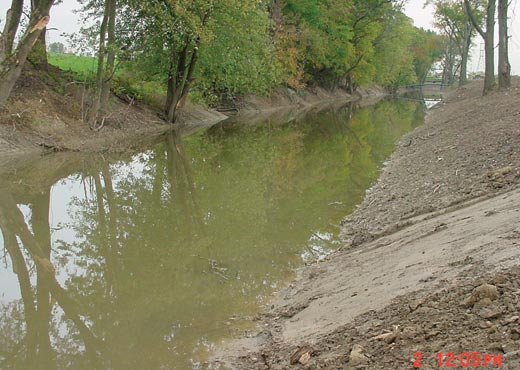
Water returned and banks reseeded.
New technical content was added to the site during March 2007 that helps users develop a list of candidate causes. The site also provides tools to analyze field data to develop evidence used to identify probable chemical, physical, and biological causes.
Several states now make it a practice to use this causal analysis to identify the causes of biological impairments in all of their water bodies that are listed as impaired. As such it has become a standard assessment within many court-ordered requirements to develop Total Maximum Daily Load (TMDL) allocations. Mississippi alone has over 750 court-ordered TMDL cases to complete within ten years. Mississippi DEQ uses the Causal Analysis process developed using the Little Scioto River as their model.
For situations requiring expensive remediation like the Little Scioto or contentions cases involving damage assessments, it is essential that the probable cause is confidently identified. The causal analysis guidance provides a rigorous, structured process that gives managers the confidence to make tough environmental protection and remediation decisions. ![]()
For more information, visit www.epa.gov/CADDIS. This article was supplied by the U.S. EPA. It does not necessarily reflect the policies of the agency.

